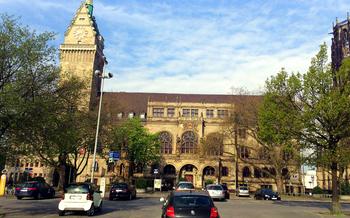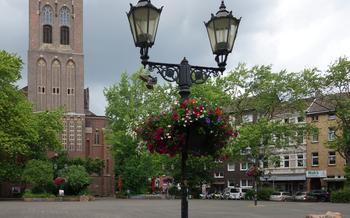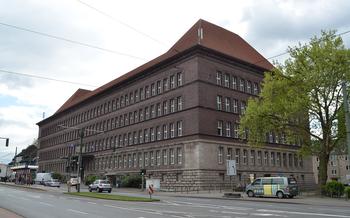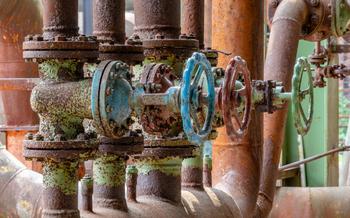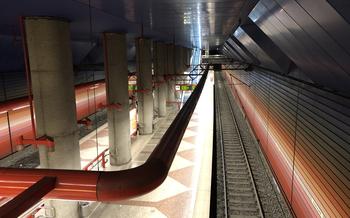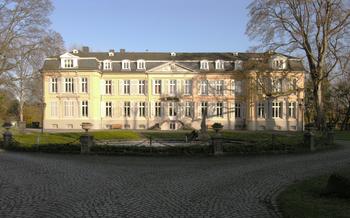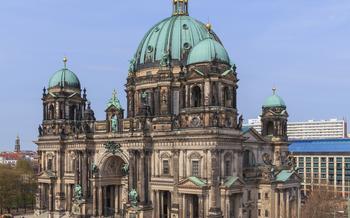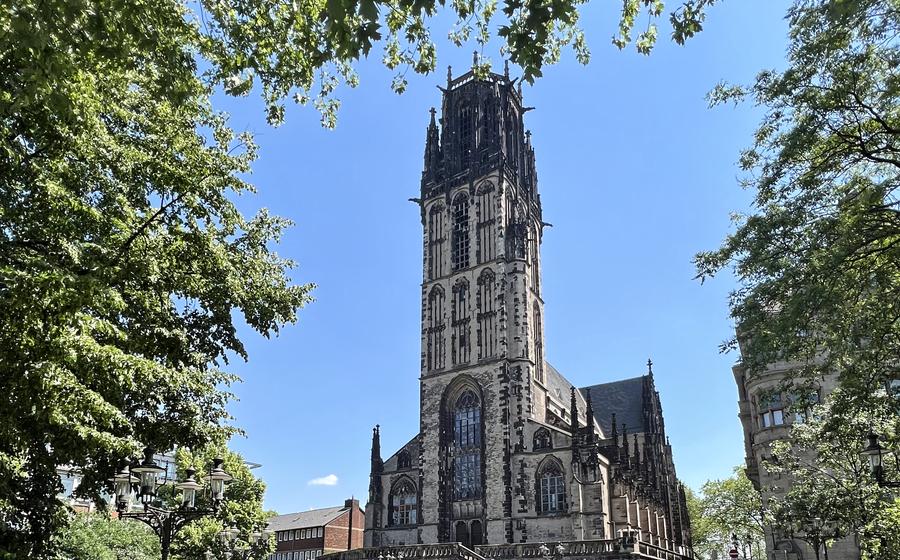
Salvatorkirche
- Salvatorkirche in Duisburg: A Historic Landmark
- Early History and Construction: A testament to Architectural Ingenuity
- Surviving World War II: A Story of Resilience
- Exploring the Interior: Discoveries and Artistic Treasures
- The Salvatorkirche Today: A Center of Community and Cultural Activity
- The Tower and Panoramic Views: A City at Your Feet
- Audio Guide Tours: An Immersive Journey through Time
- The Organ of the Salvatorkirche: A Symphony of Sounds
- Guided Tours: Unveiling Hidden Gems
- Accessibility and Facilities: Welcoming All Visitors
- Photography and Videography: Capturing Memories
- Souvenirs and Mementos: Preserving the Memory
- Insider Tip: Finding Inner Peace
Salvatorkirche in Duisburg: A Historic Landmark
In the heart of Duisburg, nestled amidst the bustling city streets, stands the majestic Salvatorkirche, a testament to the city's rich history and architectural prowess. This Gothic masterpiece, dating back to the 14th century, has witnessed centuries of change, serving as a beacon of faith, resilience, and cultural heritage. Its intricate facade, soaring spires, and awe-inspiring interiors make it a must-visit destination for anyone seeking a glimpse into Duisburg's captivating past.
Location and accessibility: The Salvatorkirche is conveniently located in the city center, within easy reach of public transportation. Visitors can take advantage of the nearby tram and bus stops, or opt for a leisurely stroll through the charming streets, soaking in the city's vibrant atmosphere.
Early History and Construction: A testament to Architectural Ingenuity
The Salvatorkirche in Duisburg traces its origins back to the 13th century, when the city was a thriving center of trade and commerce. The construction of the church began in 1260 under the patronage of the local count, Dietrich von Kleve. Skilled craftsmen and artisans from across the region were employed to bring the ambitious project to life.
The church's architectural style is a testament to the prevailing Gothic influences of the time. Its distinctive features include pointed arches, ribbed vaults, and intricate tracery work. The exterior of the Salvatorkirche is characterized by its soaring spires and buttresses, which not only lend a majestic appearance but also provide structural stability.
One of the unique features of the building is its octagonal crossing tower. This architectural element, which is uncommon in Gothic churches, is a striking landmark that dominates the Duisburg skyline. The tower's design is inspired by the famed crossing tower of the Cologne Cathedral, showcasing the influence of the region's architectural heritage.
The Salvatorkirche was built not only as a place of worship but also as a symbol of the city's power and prosperity. Its grand dimensions and intricate details reflect the pride and ambition of the Duisburg community during the Middle Ages.
Surviving World War II: A Story of Resilience
The Second World War left an indelible mark on Duisburg, as it did on many German cities. The city faced relentless air raids that resulted in widespread destruction. Amidst this devastation, the Salvatorkirche stood as a beacon of hope and resilience. Miraculously, the church survived the war with minimal damage, spared from the fate that befell many other historic buildings in the city. This remarkable survival can be attributed to a combination of factors, including its sturdy construction and a stroke of good fortune.
In the aftermath of the war, the Salvatorkirche became a symbol of hope and renewal for the people of Duisburg. The church provided a place of solace and comfort for those who had lost loved ones or their homes. It also served as a reminder of the city's rich history and enduring spirit. The restoration of the church began in the 1950s, and it was meticulously restored to its former glory. Today, the Salvatorkirche stands as a testament to the resilience and determination of the people of Duisburg, a city that rose from the ashes of war to rebuild and thrive.
Exploring the Interior: Discoveries and Artistic Treasures
Venturing inside the Salvatorkirche is like stepping into a hidden realm of artistic wonders. The church's interior is adorned with an array of notable features that captivate the eye and inspire the soul.
The stained glass windows, meticulously crafted by skilled artisans, cast a kaleidoscope of colors onto the interior, creating an ethereal and awe-inspiring ambiance. Each window tells a biblical story or depicts a saint, adding layers of symbolism and religious significance to the space.
Among the most striking artworks within the Salvatorkirche are the sculptures that grace its walls and altars. These intricate carvings, often depicting scenes from the life of Christ or the saints, showcase the incredible craftsmanship and artistic talent of their creators. The sculptures add a tangible and emotional dimension to the church's interior, inviting visitors to contemplate the stories they represent.
The rich history of the Salvatorkirche is reflected in the many artifacts and relics that adorn its interior. From ancient manuscripts and books to ornate vestments and religious objects, each item holds a story and contributes to the church's unique character. Visitors can explore these treasures, gaining a deeper understanding of the church's past and the role it has played in the lives of its congregation and the wider community.
Exploring the interior of the Salvatorkirche is an immersive journey through art, history, and spirituality. Every corner reveals a new discovery, inviting visitors to linger, contemplate, and appreciate the beauty and significance of this remarkable place of worship.
The Salvatorkirche Today: A Center of Community and Cultural Activity
In modern-day Duisburg, the Salvatorkirche continues to play a vibrant role in the community, serving as a gathering place for both religious and cultural events. As a symbol of hope and resilience, the church has become a central part of the city's identity.
Beyond its role as a place of worship, the Salvatorkirche has evolved into a hub of cultural activity. It regularly hosts concerts, exhibitions, and events that showcase the talents of local artists and musicians. These events not only provide a platform for artistic expression but also foster a sense of community and belonging among Duisburg's residents.
The church's commitment to preserving and promoting the arts is evident in its ongoing efforts to restore and maintain its historic features. Through careful renovations and collaborations with local organizations, the Salvatorkirche continues to serve as a living testament to the city's rich cultural heritage.
The Tower and Panoramic Views: A City at Your Feet
The Salvatorkirche's tower stands as a testament to its architectural grandeur and offers visitors a unique opportunity to experience Duisburg from a different perspective. Ascending the tower's winding staircase rewards you with breathtaking panoramic views of the city, its landmarks, and the surrounding landscapes. From this elevated vantage point, you can take in the vastness of Duisburg's urban tapestry, dotted with historical monuments, modern skyscrapers, and verdant parks.
As you gaze out over the cityscape, you can identify notable landmarks such as the Duisburg Inner Harbor, the Landschaftspark Duisburg-Nord, and the Duisburg City Hall. The river Rhine, a vital waterway for the city, meanders through the landscape, adding a touch of tranquility to the bustling urban scene.
The panoramic views from the Salvatorkirche's tower not only allow you to orient yourself within the city but also provide an opportunity to capture stunning photographs. Whether you're a professional photographer or an enthusiastic hobbyist, the tower offers a unique perspective to create memorable images that will serve as lasting reminders of your visit to Duisburg.
Audio Guide Tours: An Immersive Journey through Time
Enhance your visit to the Salvatorkirche with an audio guide, available in multiple languages. These guides offer a captivating journey through history, providing in-depth insights into the church's architecture, religious significance, and local legends. Listen to compelling narrations that bring the past to life, revealing hidden stories and anecdotes that would otherwise go unnoticed. With an audio guide in hand, you'll uncover the secrets of the Salvatorkirche, gaining a deeper understanding and appreciation for this remarkable landmark.
The Organ of the Salvatorkirche: A Symphony of Sounds
The Salvatorkirche is renowned not only for its architectural beauty but also for its magnificent organ. Built by the renowned organ builder Gerhard Grenzing, this instrument is a masterpiece of craftsmanship and artistry. With its 52 stops distributed across three manuals and pedal, it boasts a rich and versatile sound that has captivated audiences for decades.
The organ is a testament to the vibrant musical tradition of the Salvatorkirche. Regular concerts and recitals showcase the talents of renowned organists, filling the church with the majestic sounds of classical and contemporary compositions. The acoustics of the church are particularly well-suited for organ music, allowing the full range of tones and harmonies to resonate throughout the space.
For music enthusiasts, attending an organ concert at the Salvatorkirche is an unforgettable experience. The combination of the awe-inspiring architecture, the sublime music, and the spiritual ambiance creates a truly transcendent atmosphere. Whether you are a seasoned concertgoer or simply seeking a unique musical experience, the Salvatorkirche organ is sure to leave a lasting impression.
Guided Tours: Unveiling Hidden Gems
Immerse yourself in the rich tapestry of the Salvatorkirche's history and architecture through guided tours. Knowledgeable guides, fluent in various languages, lead visitors on an exploration of the church's hidden corners, revealing stories and insights that bring the past to life. From the intricate carvings adorning the facade to the symbolism embedded in the stained glass windows, every detail is carefully explained, allowing visitors to gain a deeper understanding of this architectural masterpiece. Whether you're a history buff, an architecture enthusiast, or simply seeking a spiritual connection, a guided tour of the Salvatorkirche promises an unforgettable experience.
Accessibility and Facilities: Welcoming All Visitors
The Salvatorkirche is committed to providing an inclusive and welcoming environment for all visitors. Accessibility features are in place to ensure that everyone can comfortably explore and appreciate the church's beauty and significance. Wheelchair ramps and elevators provide easy access to all levels of the building, including the tower. Restrooms are conveniently located and designed with accessibility in mind. Additionally, the church offers audio guides in multiple languages, allowing visitors to learn about the history and architecture at their own pace and in their preferred language.
To ensure a smooth and enjoyable visit, it's advisable to plan ahead if you have specific accessibility needs. The church staff is always ready to assist and provide any necessary support. For example, if you require assistance climbing the tower or navigating the church, don't hesitate to ask for help. With its thoughtful facilities and dedicated staff, the Salvatorkirche welcomes visitors of all abilities to immerse themselves in its rich history and spiritual atmosphere.
Photography and Videography: Capturing Memories
The Salvatorkirche's architectural grandeur and intricate details make it a photographer's paradise. While capturing the beauty of this sacred space, it is essential to be respectful of the sanctity of the church and its worshippers. Flash photography and tripods are generally not permitted, and silence should be maintained to avoid disturbing ongoing services or prayers.
To capture the best shots, consider visiting during the golden hours of sunrise or sunset when the soft light casts a warm glow on the church's exterior. The interior, with its stained-glass windows and ornate artwork, offers endless opportunities for creative photography. Experiment with different angles and perspectives to showcase the church's unique features.
For those interested in videography, capturing the Salvatorkirche's majestic presence in motion can be a rewarding experience. Create a visual narrative that highlights the church's history, architecture, and spiritual significance. Remember to obtain the necessary permits and permissions if you plan to use your footage for commercial purposes.
Share your captured memories on social media using relevant hashtags to connect with other travelers and photography enthusiasts. Your images and videos can serve as a source of inspiration for others to explore the beauty of the Salvatorkirche and Duisburg.
Souvenirs and Mementos: Preserving the Memory
For those seeking a tangible reminder of their visit to the Salvatorkirche, a variety of souvenirs and religious artifacts are available for purchase. Local artisans and craftsmen showcase their skills in creating unique gifts and mementos that celebrate the church's history and significance. From intricately designed rosaries to miniature replicas of the church itself, there's something for every taste and budget.
These souvenirs not only serve as cherished keepsakes but also support the local community and its talented artisans. By making a purchase, visitors contribute to preserving the cultural heritage of Duisburg and promoting the work of skilled craftsmen.
Whether you choose a delicate piece of jewelry, a decorative item for your home, or a meaningful religious artifact, your souvenir from the Salvatorkirche will serve as a lasting reminder of your spiritual journey and connection to this historic landmark.
Insider Tip: Finding Inner Peace
Amidst the hustle and bustle of city life, the Salvatorkirche offers a sanctuary for those seeking solace and tranquility. Step inside, find a quiet corner, and let the serenity wash over you. Let the soft light filtering through the stained-glass windows illuminate your thoughts and bring a sense of calm. Take a moment to reflect on your journey, your hopes, and your dreams. In this sacred space, you may find inspiration and a renewed sense of purpose. Leave the Salvatorkirche with your spirit refreshed and your heart filled with peace.
